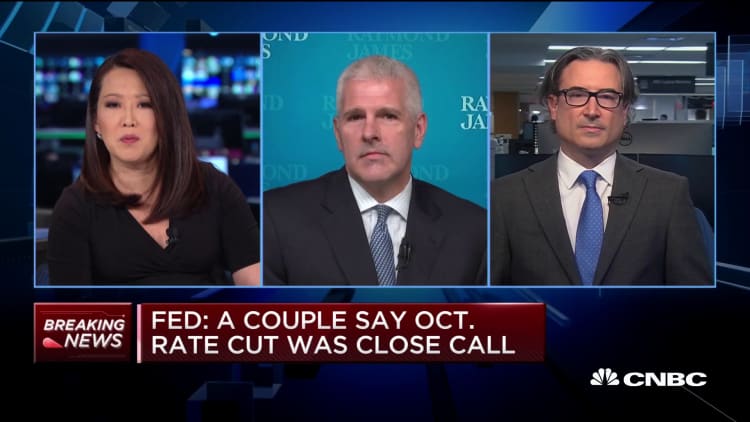After a year filled with intense worry that both the U.S. and global economy were about to tip into recession, the narrative is changing for 2020.
There's growing belief on Wall Street that the worst may be over as the overhang of trade fears, sliding corporate profits and geopolitical worries like Brexit begin to fade.
Goldman Sachs, for one, considers the slowdown that permeated 2019 as perhaps being the bottom in the growth outlook. The firm sees easier financial conditions, a strong consumer and the likelihood of a positive outcome from U.S.-China trade talks as fueling a better-than-expected picture ahead.

"This easing in financial conditions suggests not only that global growth is likely to pick up somewhat in absolute terms, but also that growth may come in stronger than currently predicted by the forecaster community," Jan Hatzius, Goldman's chief economist, wrote in a report compiled with several other economists from the firm's team.
Goldman's financial conditions index is closely watched by policymakers. It uses a variety of factors, such as bond yields, stock market prices and interest rates, to compute financial conditions. As things stand now, they are the loosest they've been since before the financial crisis, owing to a rise in the market and a Federal Reserve that changed course sharply from the tightening bias it exhibited through 2017 and 2018.
The Fed has cut rates three times this year after four increases in 2018. Those reductions not only cut borrowing costs but also helped assuage investors' nerves after Chairman Jerome Powell, in two notable missteps, gave the impression in late 2018 that the Fed would continue to raise rates and reduce the size of the bond holdings on its balance sheet.
Heading into 2020, Goldman has above-consensus calls both on U.S. GDP and global growth — 2.3% domestically against the consensus call for 1.8%, and 3.4% globally versus 3.2%.
'Decent background' for stocks
"We expect the global growth slowdown that began in early 2018 to end soon, in response to easier financial conditions and an end to the trade escalation," Hatzius wrote. "Our confidence that growth will improve sequentially is highest in the US" due to increasing demand resulting from looser conditions.
That strength should contribute to "decent background" for financial markets in early 2020, he added.
To be sure, concerns over the global backdrop remain.
Federal Reserve officials, at their October meeting, expressed continuing concern that downside risks remain both domestically and globally.
"Important factors in that assessment were that international trade tensions and foreign economic developments seemed more likely to move in directions that could have significant negative effects on the U.S. economy than to resolve more favorably than assumed," minutes from the meeting said. "In addition, softness in business investment and manufacturing so far this year was seen as pointing to the possibility of a more substantial slowing in economic growth than the staff projected."
Policymakers, though, said they expect the current interest rate level to be appropriate to foster growth, and they've given broadly optimistic estimates about where the U.S. economy stands.
Elsewhere on Wall Street, sentiment is rising that the U.S. likely will avoid the recession many thought coming just a few months ago, even if the outlook is somewhat less optimistic.
Morgan Stanley sees U.S. growth at 1.8%, along consensus lines and representing a pullback from the pace of the past two years but still positive, thanks to the Fed's "insurance" rate cuts.
"The promise and delivery of 'insurance cuts' in 2019 have paid out with strong support to the interest sensitive segments of household activity," Morgan Stanley's chief U.S. economist, Ellen Zentner, wrote. "The benefit of lower interest rates continues to support the economy in 2020, which helps to counteract less support from fiscal policy."
Other gauges also are showing decreasing levels of recession chances.
The Sahm Rule Recession Indicator, which predicts downturns based on sudden moves in unemployment, is flat. The New York Fed's predictive tool, which looks at changes in yield spreads between the 10-year and 3-month Treasurys to measure the likelihood of a recession in 12 months, is down to 29% from a recovery high of 38% recently.
DataTrek Research co-founder Nicholas Colas said that examining employment trends in critical states like Pennsylvania, Indiana, Michigan and Ohio show that "there is little risk of an imminent US recession."



